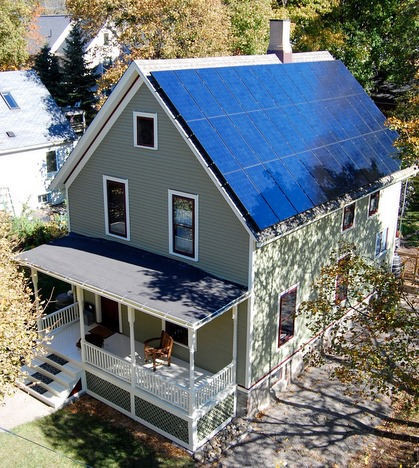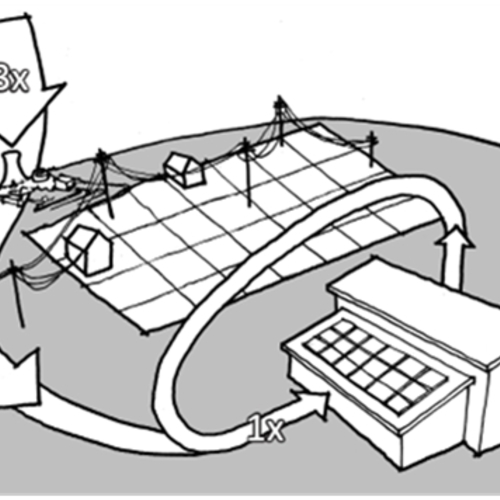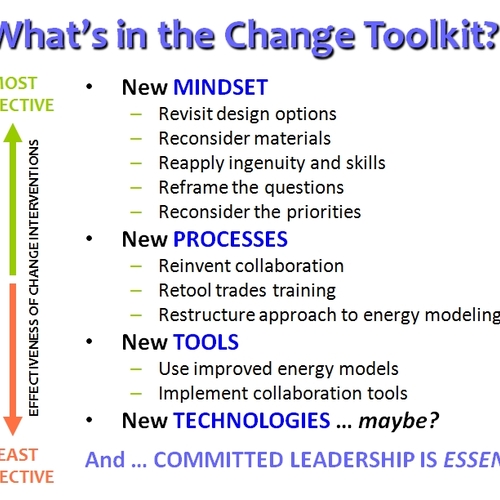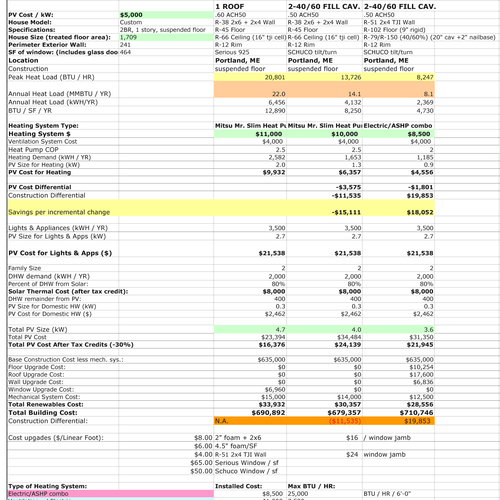
In Part 3 of this episode, the net zero conversation winds down as Phil and I talk about the “cost trade-off” game in which the homeowners will likely engage. We also have a bit of a disagreement as to how much the clients need to know about the energy-saving details being incorporated into their homes. (Good stuff.)
The Highlights:
How to make net zero cost-effective. It’s a trade-off between mechanicals and envelope design.
Photovoltaics: Expensive, but right now you get 30% off. Why aren’t we all putting PV on our homes?
Again, remember 10, 20, 40, 60: It’s a good rule of thumb to get you close to what you need. (R-10 basement slab, R-20 foundation walls, R-40 exterior walls, R-60 roof/ceiling assembly)
Net-zero ready counts! It’s relatively easy to add PV later; not so with insulation and window upgrades.
Point, counterpoint! Phil and I have different ideas about how much the clients “need to know” about the details of energy efficiency in their homes.
Lessons learned: Integrated design. Have well-established goals. Pay attention to the Germans and Canadians. Don’t be afraid of transparency—seek and share advice.
We finish with a couple of “six-digit ideas”—ideas that we think would earn a sum that has at least six digits if someone ran with them and developed them. Mine is basically improving the efficiency of a heat pump by housing it in a “passive solar shroud.” Phil’s is a six-digit idea “in hot pursuit”; he reports that a builder with whom he is working is running with one of our previous ideas, the “cellulose SIP.” Then, of course, Phil takes us out with music he thinks you should be listening to: “Shell Games” by Bright Eyes.
Also, don’t forget to go back to Part 2 where you can download Phil’s handy spreadsheet, which his office uses to help run the options and find that “sweet spot” for net-zero homes (it’s a living document that has recently been updated).
Thanks for tuning in everyone. Cheers.
TRANSCRIPT
Phil Kaplan: Where were we, Chris? We’re going to talk about how to make net-zero cost-effective.
Chris Briley: That’s right. Would you mind if I just throw that question right back at you? Because you did — you’ve done — a net-zero. Isn’t that the biggest hurdle? Net-zero sounds great — you talked a great game in the last episode — but how is it cost-effective; how is it smart?
Phil: Well, the key is to make it cost-neutral, because then it’s a home-run and there’s no reason not to be doing this.
Chris: Given the choice between two things that are equal, but one is greener…
Phil: Or more durable…
Chris: Or energy-efficient…
Phil: Right, then there’s no reason to do the first one. If we can reduce the mechanicals, improve the envelope, do everything right that we talked about previously — daylighting, solar gain to reduce the electric load, and natural ventilation — to get rid of the furnace, to get rid of fossil fuels, we can get a single point source of heat, like a wood stove or an air-source heat pump with a wood stove backup.
The furnace is gone, we have solar hot water, then we reduce our need for renewables. We use our cost optimization spreadsheet, which you can download. We’re spending $30,000 or so for all the PV we need and solar hot water, not $160,000, because we’ve done the first two things right. The costs are offset. You take that money you saved and put it in the envelope. The argument also is that PV is not that cheap now. But that’s OK, because net-zero-ready also counts. When the PV gets real cheap and your state has proper kickbacks, then you’re going to add that PV; just prep for it.
Chris: But right now, with the federal tax credit, you’re getting 30 percent off that thing, which is huge.
Phil: That begs the question: Why not do this in every home, Chris? I don’t know!
Chris: I don’t know either. I don’t have it in my house, but my roof is terrible for it.
Phil: So keep going! The truth is we do know.
Chris: Because it’s expensive!
Phil: I don’t know that it’s expensive. There are cost offsets.
Chris: Phil, can I borrow $20,000? No…. because you don’t have $20,000.
Phil: Yes, Chris, you can! I was going to spend this $20,000 on a furnace, but I don’t need a furnace. Take this $20,000.
Chris: Well done. Touché.
Phil: I honestly think it’s about that trade-off. No toe-dipping — you have to jump right in. You need to do all this to a certain point, where the need for a mechanical system drops away and you can take that money and put it in the envelope.
Chris: If you’re doing net-zero and your client is on board, it’s like jumping the Grand Canyon. You can’t do it in two steps. You have to prepare, you have to talk, you have to be deliberate in everything you do before taking one gorgeous jump across this canyon. There’s no halfway on this.
Phil: But there is a learning curve. Why not do this in every home? Well, people are still trying to figure it out. We can say 10, 20, 40, 60 — most architects don’t know what that means, and most builders don’t know what that means. They’ll laugh. Even when we draw it, if you’ve never built one before, it’s tricky. We need to figure out how to get things this airtight, and it’s a risk. It’s scary advocating not to have a mechanical system in your house.
Chris: Let’s say I’m a skeptic. There’s no way net-zero is cost-effective. Give me $12,000, I’ll put an oil boiler in my house, and boom, I’m done. None of this $40,000 PV. How is this cost-effective, Mr. Smarty-Pants Architect?
Phil: You don’t need the oil boiler. You just don’t need it.
Chris: OK. You’ll save $12,000 on the boiler because you’re not buying it, but you’ll spend $40,000 on the PV — but you’re also not going to spend $4,000 every year; you’ll spend $400 every year. In fact, essentially you’re spending nothing after you’re done. Right? Once you’re net-zero, your utility bills are zero. You’re living there for free. It’s kind of like if you took the cost of your house for 30 years, how much does it cost to live there for 30 years? With buildings in general, the construction cost represents 11% of the cost of the building. Tiny. Tiny. Buildings last a long time, and the cost of everything goes up. The construction is a fraction. But that’s what you’re getting a loan for — the construction cost. It’s what you’re investing in — this number. But you’re living in this house and it’s consuming and the numbers add up — 5 grand every year, over and over and over again. It’s a lot of money.
Phil: It is, if you start adding those numbers up. But right now, you’re going to have trouble financing that PV. You just have to have faith that the cost of PV will come down. Again, net-zero ready counts.
Chris: It will. PV will come down, oil will go up.
Phil: I have a rhetorical question. Is a commitment from the owner necessary?
Chris. Oh my gosh, yes.
Phil: Point, counterpoint. Chris Briley says yes! Phil Kaplan says, “Well, I don’t know about that…”
Chris: No way!
Phil: If it’s cost-neutral, and if the owner doesn’t care one way or the other, why even tell him? Chris, do we walk owners through the flashing details?
Phil and I would love to hear from you. If you have a great idea for an upcoming topic, want to leave general feedback, or want to share your favorite cocktail recipe, you can e-mail us at [email protected]. If you’d like to complain about our tangential ramblings, fragment sentences, or our general irreverence, you can email us at [email protected].
Chris: No.
Phil: Do they assume the building we design is going to leak?
Chris: It is not going to leak.
Phil: Do they assume the building is going to use a lot of energy?
Chris: No.
Phil: Exactly. Why do we need to tell them? They come to us for that. Why do we need to have a conversation about your wall section? No, we don’t have to have that. We just have to know we did the best job internally. Why do the owners have to know it unless it’s going to cost them more money?
Chris: The second I’ve got you pegged, you always surprise me, Phil.
Phil: We don’t need to talk about wall sections and detailing and which way the wall dries out and how much insulation. We only need to talk about quality, comfort, durability and security — and that it’s not going to cost them any more. I am proposing something radical: Don’t talk to your client about how much more insulation you’re going to put in and don’t try to sell them on it. It’s not an issue anymore.
Chris: You make the assumption that the client wants an energy-efficient house, is that what you’re saying?
Phil: Well, you make the assumption that the client wants a high quality house, right? Can you give them high quality and comfort that doesn’t cost more? As long as the client wants that, we’re not going to talk about anything else.
Chris: You’ve blown my mind, Phil. But there’s a part of me that wants to say, Wait, I want to show the client what I’m working on.
Phil: That’s the geeky ego. I have a hard time resisting that.
Chris: I know! Look at this! Look at the gorgeous detail, Mr. Client! Look at what I’ve done for you!
Phil: Look at how smart I am! But really, we have bigger goals now. In ten years we’re not going to be talking about it. We don’t tell clients we’re using 2×6 walls or batt insulation; they don’t give a damn. Ten years from now, they’re not going to give a damn about double-stud walls or 4 inches of rigid foam. Most don’t give a damn now.
Chris: And the name of my business won’t be Green Design Studio, because Green will be meaningless.
Phil: Unless you change your last name to Green.
Chris: Which maybe I’ll do.
Phil: OK, let’s talk about the lessons we’ve learned doing net-zero homes. I know I sounded cavalier about it, but we’re here to push a little bit.
Chris: It could be the drink. It makes you sound tough.
Phil: I wish it were that simple.
Chris: What are the lessons you’ve learned?
Phil: There’s been a lot of talk about the integrated design process — getting the builder on board early.
Chris: You and I do that all the time. When’s the last time you’ve taken a house out to bid traditionally?
Phil: Not.
Chris: Me neither. It just doesn’t happen anymore.
Phil: You just have to advocate to your client that’s not the smartest way to go.
Chris: We have to do a podcast on the construction contract of delivering your green house.
Phil: We have some good builders around here who do that on a regular basis.
Chris: You have a design plan, elevations, wall sections, that’s it — and the rest is all assumptions. You invite some builders in to talk about it. They become part of the team — not only for the price and cost, but also for some of the responsibilities of delivering this. You’re not going to hit an ach50 of 0.6, or 1 even, without the builder being fully on board for delivering a tight house. If they just want to do business as usual and get this thing done and go home…
Phil: Or not lose money and say to the client, “I could save you a lot of money by not doing this. Trust me, it’ll be close enough, don’t worry about it.”
Chris: “I’ve been building like this for years. It’s how my dad taught me.”
Phil: So, you’ll get yourself in trouble without an integrated design process.
Chris: And we want good numbers, right? Integrated design process — and you have goals in terms of … You want net zero and you have the builder and client at the table, and you say, “Here’s where we need to be, folks. We want a HERS score of about 40. We want our Btu per square foot to be…” What?
Phil: I say 20,000.
Chris: Btu per square foot per year.
Phil: A Passivhaus is under 5,000 Btu, but we don’t have to get that low.
Chris: Cause we’re going to supplement with PV. Or something.
Phil: Down to 20,000, but if we get down lower that’s great.
Chris: And your ach50—you want to try for 1.0. You get a pat on the back and the stamp of approval from Green Architects’ Lounge that you designed and built a nice house.
Phil: But you can get a 0.6. You, builder right there, you can’t do it? I’m telling you, you can, if you’re good enough.
Chris: If you’re man enough.
Phil: But the math is hard.
Chris: You know what’s working for you? The sun. It rises and sets each day and gives you free light and heat. You’ve got to work with that, right?
Phil: Right. You’ve got to use it. It’s free. Pay attention to the Canadians and the Germans.
Chris: What’s up with them? They’re culturally opposite, don’t you think? But they come from northern climes, and we can get really great glazing from the Canadians. And from the Germans.
Phil: Canadians do it a little cheaper. Germans do it a little better. Martin Holladay has a great slide from his superinsulation slide show: It’s not the Canadians and the Germans; it’s the Canadians and the hippies. Don’t be afraid of transparency. Give and receive, learn, read, research; don’t do this yourself.
Chris: And balance. You can overglaze and you can underglaze. We gravitate toward those great light spaces, but dude, be careful. It’s a delicate dance. Use those energy models. What else, Phil?
Phil: Have clear goals at the outset. Know what you’re going for. Yes, net-zero is one.
Chris: But everything it entails.
Phil: The clear goals at the outset, when you sit down with your client, are to say we want to be net zero. Are you on board? Here’s what we need to do. Not to say, “Well, we did a pretty good house. Do you want to take it to net zero?” Too late. The bird has flown.
Chris: I think we’re wrapping up this thing.
Phil: Do you have a six-digit idea, Chris?
Chris: You know I do. The minisplit is all the rage, right? I can’t be the first one to think of this. In cold climates, what’s the problem with heat pumps? The colder it gets, the less efficient they are — which is the most annoying thing about them, because you need them the most when it’s cold.
I just went to a great heat-pump seminar. The truth is most of your heating and cooling is in the more moderate seasons. Rarely here in Maine does it stay below zero. At that point, is my COP 1 because the resistance is on?
Here’s my point: Can we make a directional minisplit unit? By that I mean, instead of having a unit that sits outside the building shedding cold and pumping heat into your house, can’t we make it directional and put most of it in a passive solar box? You’d have a tiny passive solar building that the compressor sits in, so when it’s 1 degree outside and sunny, it’s probably 30 in that thing, where its efficiency is much better and it’s throwing heat outside the box. I’m talking about passive solar heating of the unit to keep it warm.
Phil: It’s clever, but how much does it cost to build a building for the unit?
Chris: Go to Home Depot, 85 bucks. But I’m saying, “Hey manufacturers, hey Japanese!”
Phil: The minisplits need some ventilation around them, though, right?
Chris: They need lots of ventilation.
Phil: So you’d need an open box, right?
Chris: Yeah, but blow it out all to one side, like my laptop ventilates.
Phil: Did you just tell me to blow it out one side, Chris?
Chris: Yeah, blow it out to one side! Do you have a six-digit idea, hotshot?
Phil: I don’t have a six-digit idea; I have a six-digit idea in hot pursuit.
Chris: Ooo, now I’m interested! Is this a new segment?
Phil: We need hot pursuit music from “C.H.I.P.S.” So, you mentioned cellulose SIPs, right?
Chris: Yeah, a long time ago. Why not?
Phil: And we talked about doing a deep-energy retrofit. Wouldn’t it be great if there were a deep-energy retrofit system that included the windows? Well, we’re working on a deep-energy retrofit project and we’re doing some brainstorming around those ideas, so stay tuned. We’re working on a SIPS panel with Paradigm triple-glazed windows pre-installed. I think we could be in and out in three days.
Chris: No way! That’s the holy grail! Perhaps. Except for the vinyl. Paradigm, I love you, but…
Phil: It’s affordable, though. If we could do this affordably, we could change a lot of houses. Stay tuned.
[The guys end with a friendly discussion about Conor Oberst, his band Bright Eyes, hipsters, Omaha, and Phil as the coolest guy in town. They listen to the Bright Eyes song “Shell Games.”]
Weekly Newsletter
Get building science and energy efficiency advice, plus special offers, in your inbox.















3 Comments
Shooting down the six-digit idea
Chris,
Here's why your six-digit idea won't work: during the winter, the outdoor condenser is gathering all of the heat needed to heat your house. That takes a tremendous amount of air flow, because the condenser is lowering the temperature of the outdoor air -- squeezing out heat -- and there isn't much heat available outdoors at that time of year.
A little passive-solar doghouse doesn't contain much air volume. That outdoor condenser needs to blow a huge volume of air -- something like what you'd find in a high-school gym. (I don't know the time unit for that volume, but you get the idea.) If you build your passive-solar doghouse, the doghouse air will be sucked through the unit in 10 seconds. After that, the unit will be pulling outdoor air from the entire neighborhood.
Net-Zero for Existing Homes
While there is a lots of talking for designing new net-zero homes, it's important to also consider that we can retrofit existing homes to be net-zero. And as Phil and Chris point out, this can be cost effective as well. So cost effective that you could price out the net-zero updates to be the same as a standard remodel update. There are numerous trade-offs that need to be made such as the ones pointed out in this piece. We have an extensive listing of such options here.
song was Conor Oberst
Log in or create an account to post a comment.
Sign up Log in